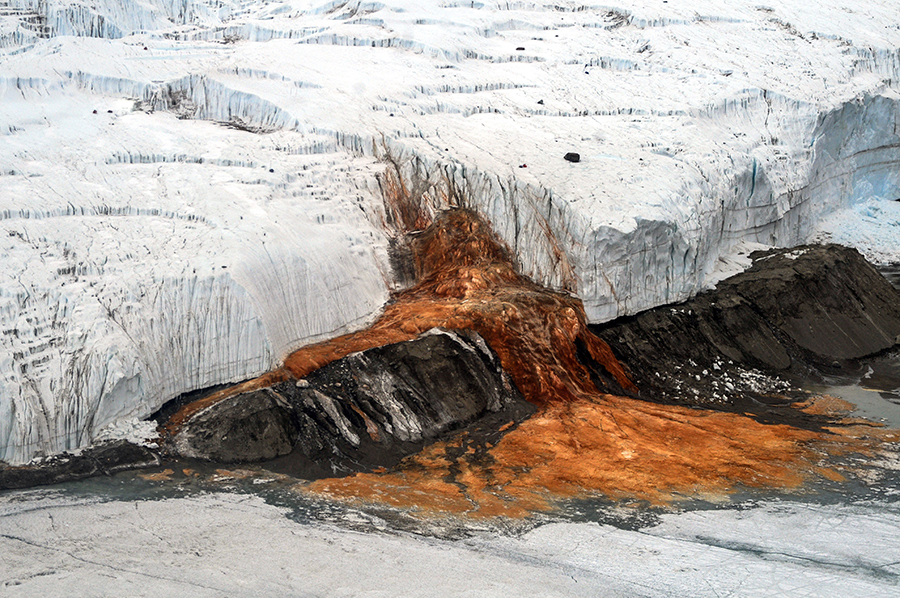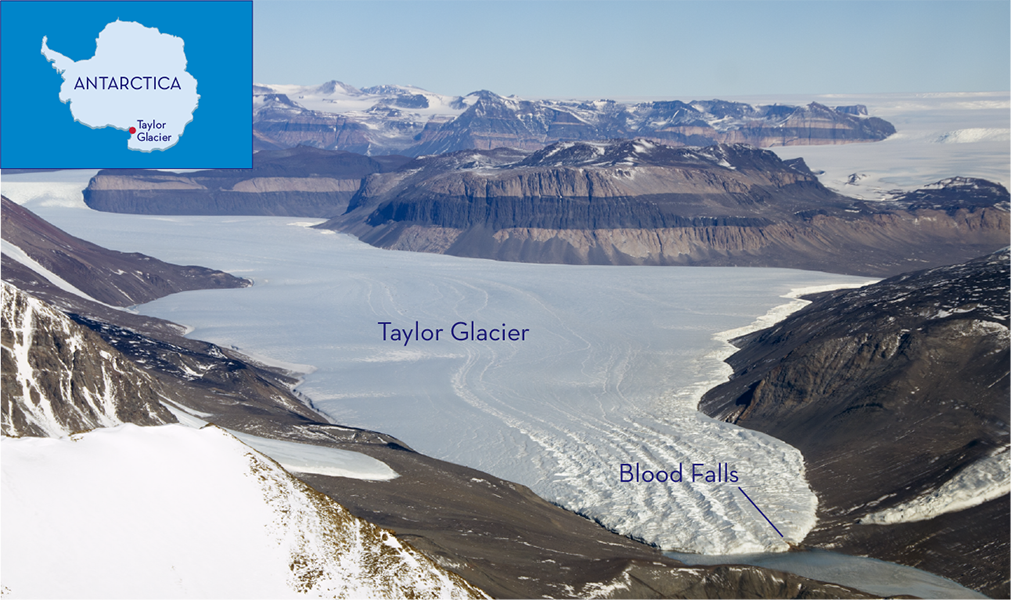|
Video credit: Carr et al/JGR: Earth Surface/AGU. This timelapse footage shows a wintertime brine release from Blood Falls captured in May 2014.
Wintertime flow of Blood Falls caught on camera for the first timeScientists are trying to pinpoint why the unusual waterfall flows when it doesPosted May 02, 2022
Researchers have caught a wintertime release of brine from Blood Falls on camera for the first time, but the exact cause of the curious phenomenon remains a mystery. 
Photo Credit: Elizabeth Mockbee.
Dried brine at Blood Falls at the terminus of Taylor Glacier. The briny, iron-rich liquid oxidizes rapidly at the surface, giving the ice its distinctive bloodstained coloration.
Blood Falls is a five-story-tall blood-red waterfall in Taylor Valley, Antarctica, the only waterfall of its kind on Earth. Unlike a regular waterfall, Blood Falls spurts out red, briny water from the terminus of Taylor Glacier onto the ice-covered surface of Lake Bonney. But why red? Iron oxides in the brine are what give the Falls its distinctive color. The blood-red brine comes from sediments underneath Taylor Glacier that are saturated with super-salty water. It's a bit like a sponge: Pockets of brine are trapped in the holes of the sediment sponge. The brine doesn't flow continuously, but rather gushes out of the glacier terminus in short spurts. Scientists discovered Blood Falls in 1911 but are still unsure how the brine gets pumped to the surface and what causes the brine to flow when it does. In 2014, researchers placed a camera at the glacier terminus to watch Blood Falls flow over time. The camera captured a large release of brine over the course of about four weeks in May of that year, the first time a brine release from the Falls was recorded on video during the austral winter. In a new study, researchers compared the footage to data from nearby seismic sensors to see if cracks opening in the glacier's ice might be causing the brine to flow. Surprisingly, the seismic sensors didn't pick up any evidence of cracks or icequakes large enough to trigger a flow of brine. So while the mechanism behind Blood Falls is still a mystery, the research is helping scientists narrow down the possibilities of what might be causing it. “There's a lot of parts of the system that we know, but we still don't know what that actual initial triggering event is, of why now and not some other time,” said Chris Carr, a glaciologist at Los Alamos National Laboratory and lead author of the new study. An unexplainable mysteryScientists began monitoring the Blood Falls area more regularly in the early 1990s, when Long-Term Ecological Research began in the McMurdo Dry Valleys, where Blood Falls is located. At that time, glaciologists entertained all manner of possibilities for what might be triggering the brine flow - even the idea of a volcano being underneath the glacier. “We were just throwing out the most bizarre ideas because none of it made sense and we didn't have very much data to draw from,” said Erin Pettit, a glaciologist at Oregon State University and co-author of the new study. The graphic (right) shows a conceptual map of the glacier terminus. The authors of the new study joke that they're still trying to figure out that “magic arrow” - the red dashed arrow going from the saturated subglacial sediments to the Falls themselves. 
Image Credit: NSF.
This graphic shows where the source water for Blood Falls is in relation to Taylor Glacier and the Falls themselves.
“All of our lives for the last decade have been trying to figure what that giant magic arrow is,” Pettit said. Over time, researchers eliminated some possibilities of what could trigger the brine release (including the volcano theory), but they still don't understand what forces brine to flow to the surface. Basically, they know how it could be happening, but they don't know why. “To get that brine out, you have to either increase the pressure of the brine so much that it can push through and crack the ice above it, or you have to crack the ice above it… or you have to have the ice flow and open a connection through how it flows,” Carr said. “Then the question is: 'Okay, but why?' Why will the ice change in a way that opened up a connection? Why would the pressure change in a way that increased enough? Why would the cracks drive all the way down to the bottom?” Unfortunately, footage from the brine release in May 2014 didn't help them answer any of those questions. Seismic sensors are stationed around Taylor Glacier to pick up quakes in the ground and glacier ice itself, so Carr and her colleagues compared the camera footage to the seismic data. They found cracks were opening in the glacier ice, but those rifts weren't associated with the brine flow caught on camera. They're in fact just cracks that regularly form due to the ice flowing and the air temperature fluctuating. Any cracks opening to let brine flow through are either too small to detect or open too slowly for scientists to pick them out of the seismic noise, Carr said. 
Photo Credit: NASA Earth Observatory
An aerial image of Taylor Glacier in Taylor Valley, part of the McMurdo Dry Valleys, the largest ice-free region of Antarctica.
One thing the researchers do know is that since this particular brine flow happened in the winter, it wasn't due to a pond of meltwater triggering a crack in the glacier: it was simply too cold for meltwater to form. That magic arrow will likely remain a mystery for some time, but the researchers are not deterred. Carr now suspects some change might be happening at the base of the glacier that causes Blood Falls brine to gush out. “We're slowly getting to a point that we can triangulate on what might really be going on,” Pettit said. This research is supported by the National Science Foundation, which manages the U.S. Antarctic Program. NSF-funded research in this story: Erin Pettit, Oregon State University, award 1144177. |
"News about the USAP, the Ice, and the People"



For USAP Participants |
For The Public |
For Researchers and EducatorsContact UsU.S. National Science FoundationOffice of Polar Programs Geosciences Directorate 2415 Eisenhower Avenue, Suite W7100 Alexandria, VA 22314 Sign up for the NSF Office of Polar Programs newsletter and events. Feedback Form |


